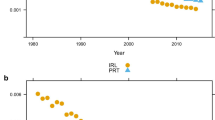Standardization

Standardization is a classic epidemiologic method for comparison of rates. For example, we often use standardized mortality ratios to compare the death rates of a study population with that of a standard population because of the difference in age structures and age-specific rates in the two populations being compared. Standardization is used as a method of removing the effect of potential confounders. There are two methods of standardization: direct method and indirect method. The direct method of standardization is preferred over the indirect method because the latter does not always guarantee to achieve standardization. This chapter will provide steps for calculating both direct and indirect standardization methods with practical examples and exercises.
This is a preview of subscription content, log in via an institution to check access.
Access this chapter
Subscribe and save
Springer+ Basic
€32.70 /Month
- Get 10 units per month
- Download Article/Chapter or eBook
- 1 Unit = 1 Article or 1 Chapter
- Cancel anytime
Buy Now
Price includes VAT (France)
eBook EUR 85.59 Price includes VAT (France)
Hardcover Book EUR 105.49 Price includes VAT (France)
Tax calculation will be finalised at checkout
Purchases are for personal use only
Similar content being viewed by others

How to measure premature mortality? A proposal combining “relative” and “absolute” approaches
Article Open access 26 October 2021

Standardization and Decomposition Analysis: A Useful Analytical Method for Outcome Difference, Inequality and Disparity Studies
Chapter © 2015

Quantitative Methods: Basics of Epidemiology and Biostatistics
Chapter © 2023
References
- National Center for Health Statistics. Vital statistics of the United States, 1978. Washington; 1982. Report No.: PHS. p. 83–1101. Google Scholar
- Xu J, Murphy SL, Kochanek KD, Arias E. Deaths: final data for 2019. Natl Vital Stat Rep. 2021;70(8) Google Scholar
- Naing NN. Easy way to learn standardization : direct and indirect methods. Malays J Med Sci. 2000;7(1):10–15. PMID: 22844209; PMCID: PMC3406211. Google Scholar
Author information
Authors and Affiliations
- Epidemiology Division, Department of Epidemiology and Biostatistics, Arnold School of Public Health, University of South Carolina, Columbia, SC, USA Anwar T. Merchant
- Anwar T. Merchant


